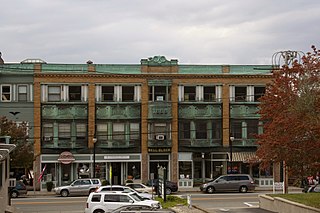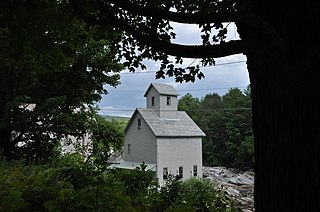
Hope Valley is a village and census-designated place (CDP) in the town of Hopkinton in Washington County, Rhode Island, United States. The population of the CDP was 1,612 at the 2010 census. Hope Valley is the largest village in Hopkinton and the town's principal commercial center. While the village of Hope Valley is located in Hopkinton, its zip code, 02832, extends into the neighboring town of Richmond.

Wakefield is a village in the town of South Kingstown, Rhode Island, United States, and the commercial center of South Kingstown. Together with the village of Peace Dale, it is treated by the U.S. Census as a component of the census-designated place identified as Wakefield-Peacedale, Rhode Island. West Kingston, another South Kingstown village, was the traditional county seat of Washington County. Since 1991, the Washington County Courthouse has been in Wakefield. The Sheriff's Office which handles corrections is also in Wakefield.

Pawtuxet Village is a section of the New England cities of Warwick and Cranston, Rhode Island. It is located at the point where the Pawtuxet River flows into the Providence River and Narragansett Bay.

Silvermine is an unincorporated community in Fairfield County, Connecticut, United States that extends across three southwestern Connecticut towns: Norwalk, New Canaan and Wilton.

The Gilbert Stuart Birthplace and Museum is located in Saunderstown, Rhode Island, US. Gilbert Stuart was born on December 3, 1755, in the colonial-era house located on the property, becoming a famous American portraitist of the 18th and 19th centuries. The museum consists of the 1750 house in which Stuart was born, an operational snuff mill, an operational grist mill, a mill pond, streams, a fish ladder, nature trails, an herb garden, and a welcome center and art gallery.

Falls, is an unincorporated community in Wake County, North Carolina, United States, situated on Old Falls of Neuse Road, between Raleigh and Wake Forest, near the Wakefield Plantation development. Falls Dam, on the Neuse River, is within the community.

Carolina is a village that straddles the border of the towns of Charlestown and Richmond on the Pawcatuck River in Washington County, Rhode Island. Rhode Island Route 112 passes through the village. Carolina is identified as a census-designated place, with a population of 970 at the 2010 census.

The Perry Mill is a historic mill building at 337 Thames Street in Newport, Rhode Island. It is a large three-story stone structure on the Newport waterfront. It was built in 1835 by master stonemason Alexander MacGregor as part of an initiative to boost the city's flagging economy. Of the four mills built in the 1830s only this one and the Newport Steam Factory survive. This building was originally four stories when built.

Boyd's Windmill, also known as Boyd's Wind Grist Mill, is a historic smock mill at Paradise Valley Park on Prospect Avenue in Middletown, Rhode Island. John Peterson built the windmill at the corner of Mill Lane and West Main Rd. in Portsmouth, Rhode Island in 1810, and William Boyd purchased it in 1815. It originally had four common sails, but four more were added by the family. The mill is a timber-frame structure, octagonal in shape, and about 30 feet (9.1 m) tall, with a rotating cap powered by eight vanes with canvas sheets. The grindstones in the middle of the mill are Fall River granite; the upper one, which is connected to the power mechanisms, rotates six times for each turn of the mill's main shaft. In 1916 Benjamin Boyd removed the original vanes and powered the mill using a gasoline engine. It is one of only two historic windmills to survive on Aquidneck Island.

The Hopkins Mill District is a historic district in Foster, Rhode Island. It encompasses a historic mill village that extends along Old Danielson Pike between its two junctions with Danielson Pike. The area has been the site of mills since the 18th century, and includes one of Foster's oldest houses, the c. 1720 Hopkins-Potter House at 21 Old Danielson Pike. Prominent public buildings in the district include the c. 1830 Curtis Hall at 18 Danielson Pike, which was long used as a tavern and social gathering place, and the 1869-71 Hopkins Falls Union Church.

The Wanskuck Historic District is a historic district in the city of Providence, Rhode Island encompassing a mill village with more than two hundred years of history. As early as the mid-18th century, mills stood on the West River in northern Providence, a development which continued with the rise of industrialization in the 19th century. The mill village of Wanskuck is organized around three thoroughfares: Branch Street, Veazie Street, and Woodward Road, and is roughly bounded on the east by Louisquisset Pike and to the northwest by the city line with North Providence. The West River runs through the district, with its banks lined by two late-19th-century mill complexes. The village area includes a variety of examples of mill worker housing, from duplexes to rowhouses, as well as two church complexes and a community hall built in 1884 by the Wanskuck Company.

Usquepaug is a village in the towns of Richmond and South Kingstown in Washington County, Rhode Island, United States. It is located along the Usquepaug River. A portion of the village is listed on the National Register of Historic Places as the Usquepaug Road Historic District.

The Hamilton Mill Village Historic District is a historic district encompassing a small mill village in North Kingstown, Rhode Island. It is located on the south side of the Annaquatucket River, near its mouth at Bissell Cove. The village includes two wood-frame mill buildings and a collection of mill worker housing units, which line a short section of Boston Neck Road as well as Salisbury Avenue, Web Avenue, and Martha Road. The most impressive mill building is the main mill, built in 1853 and enlarged in 1866 with a double clerestory roof, something not found in other surviving mills in the state.

Hillsdale Historic and Archeological District is a historic district in Richmond, Rhode Island. The district was added to the National Register of Historic Places in 1980. It represents the site of the former textile mill village of Hillsdale.

The East Blackstone Village Historic District is a historic district roughly along Elm Street at the junction with Summer Street in eastern Blackstone, Massachusetts. It encompasses a small 19th-century mill village center that developed along what was once a major roadway connecting Worcester with Providence, Rhode Island. The district was added to the National Register of Historic Places in 1995.

The Daniel's Village Archeological Site is an historic industrial archaeological site in Killingly, Connecticut. Located in the vicinity of the crossing of Putnam Road and the Five Mile River, the area is the site of one of the earliest textile mills in Connecticut. The mills burned in 1861 and were not rebuilt, ending the village's economic reason to exist. The site was added to the National Register of Historic Places in 1978. The entire site was purchased in 2015 by a historic building expert who has put the original parcel back together. It is now private property.

The Graniteville Historic District is a mainly residential historic district in Waterford, Connecticut. It is ranged along Rope Ferry Road, near granite quarries that were once a major industry in the town. Most of the 31 historical buildings in the district are plain residences occupied by quarry workers; also included are the c. 1878 Graniteville School at 239 Rope Ferry Road, and the house of John Palmer, one of the proprietors of the quarries, at 218 Rope Ferry Road. His house, a c. 1860 Italianate updating of an older house, is the most elaborate house in the district. The district was listed on the National Register of Historic Places in 2003.

The Moses Taft House is a historic house at 111 East Wallum Lake Road in Burrillville, Rhode Island. The 1+1⁄2-story side-gable Cape style house was built in 1786, and is a well-preserved example of early Federal architecture. It exhibits the typical five-bay facade, with the entry in the center bay, and a large central chimney. The house underwent a major restoration in the 2000s. Moses Taft, an early owner of the house, was a farmer and operated a nearby grist mill on the Clear River, with Seth Ross, who resided on Eagle Peak Road.

The Kingsley Grist Mill Historic District encompasses a well-preserved small late 19th-century mill complex with surviving 18th-century remnants a Gorge and East Roads in Clarendon, Vermont. The complex includes a house, barn, mill and other outbuildings, and the nearby Kingsley Covered Bridge. The district was listed on the National Register of Historic Places in 2007.





















